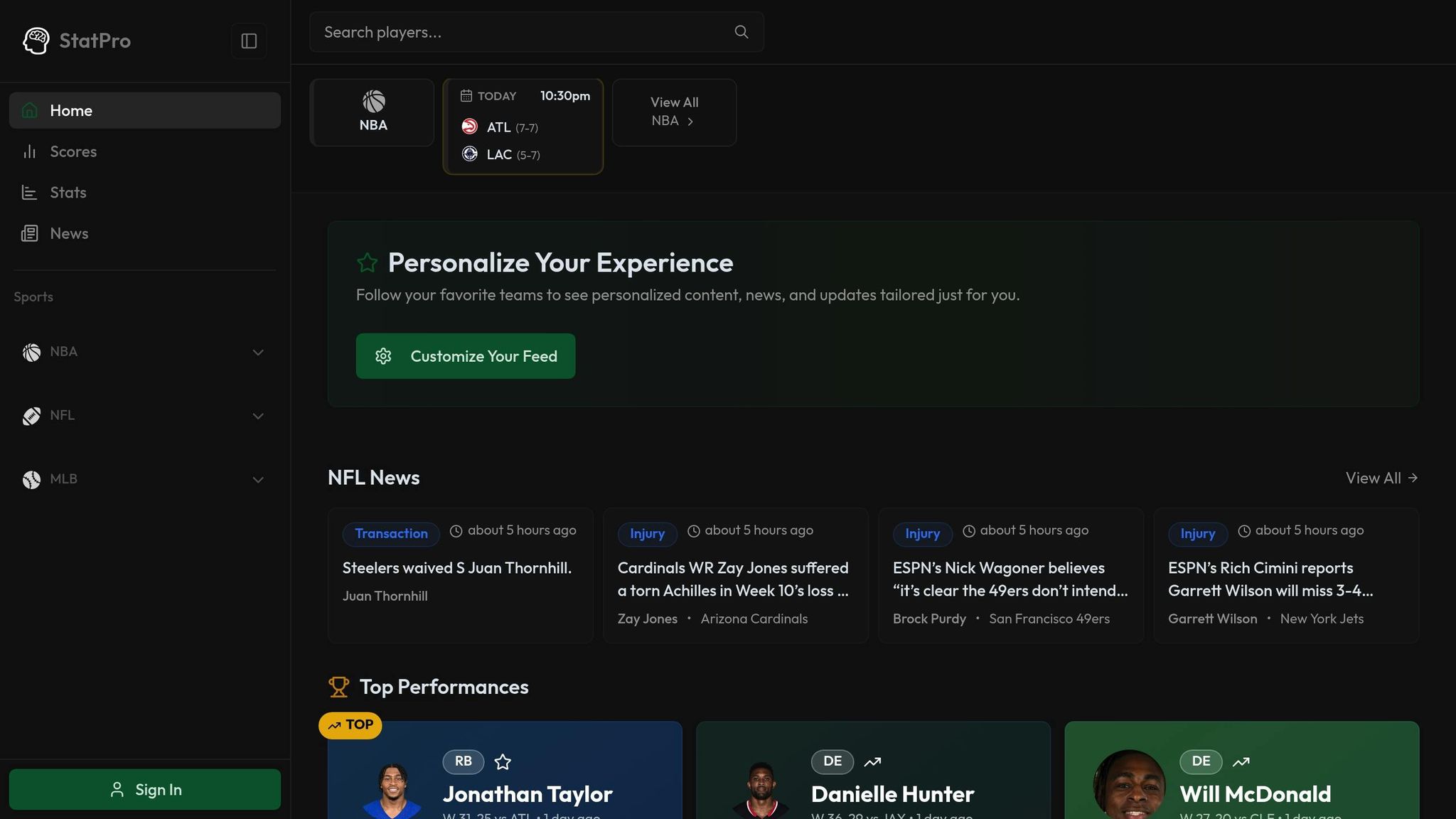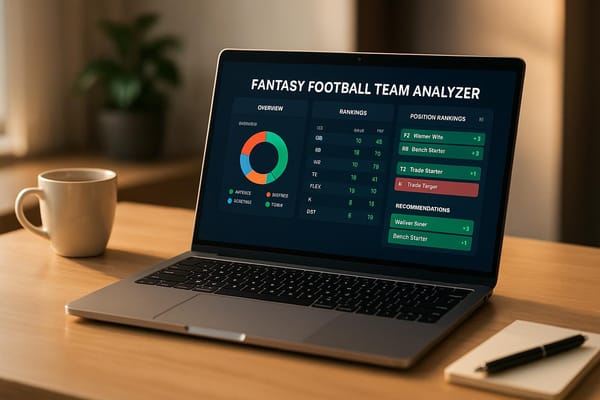Fantasy Football Draft Checklist: 15 Must-Do Steps
Prepare for fantasy football dominance with 15 essential draft strategies, from understanding league settings to leveraging advanced metrics.

Fantasy football success starts with preparation. This guide breaks down 15 actionable steps to dominate your draft, from understanding your league's scoring system to using advanced player metrics. Here's the quick takeaway:
- Understand League Settings: Know if you're in PPR, half-PPR, or standard scoring.
- Analyze Advanced Metrics: Use stats like target share, red zone touches, and snap counts to assess player value.
- Track Trends: Monitor ADP shifts, injury updates, and offseason changes.
- Mock Drafts: Practice to refine your strategy and identify value picks.
- Stay Flexible: Use tiers, plan for bye weeks, and have backup options.
Tools like StatPro can provide real-time insights, helping you make smarter picks under pressure. Ready to draft smarter? Let’s dive in.
The BEST Strategy in 2025 Fantasy Football Drafts (+ a PPR Mock Draft)
Draft Preparation Basics
Before diving into your draft, it’s crucial to get familiar with your league’s scoring system.
Know Your League Settings
The way your league awards points directly impacts player value. For instance, in PPR leagues (Points Per Reception), players who rack up catches - like wide receivers and pass-catching running backs - gain extra value. On the other hand, standard leagues emphasize touchdowns and rushing yards, making power runners and high-scoring players more valuable. If your league uses half-PPR, it strikes a middle ground between the two. Understanding whether your league follows PPR, half-PPR, or standard scoring is the first step toward evaluating players and crafting a winning draft strategy. This knowledge sets the stage for every decision you'll make during the draft.
Study Player Performance Trends
Check Positional Rankings and ADP
15 Must-Do Steps for Your Fantasy Draft
After laying the groundwork for your fantasy football draft, it's time to refine your strategy. These 15 steps will help you prepare and execute your draft plan, giving you the best shot at assembling a winning roster.
Step 1: Dive into Player Performance Analytics
Go beyond basic stats and analyze advanced metrics. Look at target share, red zone touches, and snap count percentages to pinpoint players who consistently get opportunities. For running backs, metrics like yards after contact are key, while air yards can reveal wide receivers who bring extra value to the table.
Efficiency stats, such as yards per target and touchdown rate, can also signal potential regression. Players with extreme numbers in these areas often trend back toward average, which could create draft-day bargains. Tools like StatPro's analytics dashboard can help you uncover these insights.
Step 2: Identify Sleeper Picks and Late-Round Gems
Focus on players who showed promise in their rookie seasons or finished strong last year. These players often see expanded roles in the following season.
Pay attention to high-powered offenses - even secondary options can deliver solid fantasy value. Also, consider handcuff running backs who could step into a lead role if the starter gets injured. A third receiver on a team with a pass-heavy scheme can also be a sneaky good pick.
Step 3: Keep Tabs on Injuries
Create a tiered injury watch list to track players' health. Recovery timelines vary: ACL injuries often take 10-12 months, while soft tissue injuries like hamstring strains can linger. Use tools like StatPro's injury tracker to stay updated.
Don’t completely avoid injured players - just adjust their draft position based on risk. Sometimes, a first-round talent slipping to the third round due to injury concerns can be worth the gamble.
Step 4: Watch ADP Trends for Value
Average Draft Position (ADP) shifts constantly during the preseason due to news, injuries, and training camp reports. A player whose ADP drops a couple of rounds might become a value pick. On the flip side, be wary of players whose ADP skyrockets without a clear reason.
Check ADP data across multiple platforms to spot discrepancies. If a player is going much later on one platform compared to others, you might have found a market inefficiency to exploit.
Step 5: Review Expert 'Do Not Draft' Lists
Experts often flag players for reasons like age, new offensive systems, or unsustainable production. While these lists are helpful, don’t blindly follow them. Sometimes, the consensus leads to players being undervalued. If a player’s ADP falls far enough, the potential reward might outweigh the risk.
Step 6: Practice with Mock Drafts
Complete 5-7 mock drafts tailored to your league’s settings. This helps you understand draft trends, such as when positional runs occur, and allows you to experiment with different strategies.
Mock drafts also reveal which mid-round players you consistently target and whether your preferred picks align with their current ADP.
Step 7: Use Positional Tiers
Instead of rigid rankings, group players into tiers of similar expected production. This way, you can wait for the last player in a tier before moving on to another position.
Identify drop-off points where talent significantly declines. For example, if there’s a clear gap after the top 12 wide receivers, plan to grab one before that tier ends.
Step 8: Examine Team Depth Charts
Look at projected snap counts and role distributions. A starting running back might only see 60% of snaps if the team uses a committee approach. Seek out bellcow backs who handle rushing, receiving, and goal-line duties.
For wide receivers, pay attention to slot receivers in high-volume passing offenses. They often provide a safer floor compared to outside receivers who rely on big plays.
Step 9: Plan for Bye Weeks and Playoff Matchups
Spread out bye weeks among your key players to avoid lineup gaps. Losing multiple starters in the same week can cost you a crucial win.
Also, check the strength of schedule for Weeks 15-17 (fantasy playoffs). Players with favorable matchups during these weeks can be difference-makers.
Step 10: Factor in Off-Season Changes
Keep track of free agency moves, trades, and coaching changes. A wide receiver moving to a pass-heavy team could see a boost in targets, while a player losing offensive line support or facing a quarterback downgrade might struggle.
Changes in offensive coordinators can also signal shifts in team strategy, benefiting certain players while lowering expectations for others.
Step 11: Look for Rookie and Sophomore Breakouts
Second-year players often make significant strides as they adjust to the NFL. Focus on rookies who performed well in limited opportunities or whose teams didn’t bring in competition at their position.
Pay attention to draft capital - teams tend to give more chances to players picked in the first two rounds.
Step 12: Maintain Roster Balance
Don’t get caught up in positional runs. If running backs are flying off the board, pivot to wide receivers or another position where the value is better. Reaching for a lesser player just to keep up can hurt your roster.
Build your roster based on league requirements. For example, if your league starts three wide receivers, prioritize depth at that position over stacking running backs on your bench.
Step 13: Use Cheat Sheets and Draft Tools
Real-time tools like StatPro’s cheat sheets adjust player values as your draft unfolds. They highlight the best available players based on your roster needs and league settings.
Set up player alerts for your sleeper picks so you don’t miss out in the later rounds. These tools help you stay organized in the fast-paced draft environment.
Step 14: Have Backup Plans
Always have contingency options ready. If your top target gets picked right before your turn, have 2-3 alternatives lined up. This prevents panic picks that can derail your strategy.
Be flexible and prepared for unexpected trends. For instance, if quarterbacks start going earlier than expected, adjust your approach rather than sticking rigidly to pre-draft rankings.
Step 15: Document and Review Your Strategy
Write down your draft plan, including your preferred order by position and round-by-round goals. This keeps you focused when the pressure is on.
After each pick, reassess your needs and adjust your targets as necessary. Stay flexible, but stick to your overall strategy to build a balanced and competitive roster.
Player Performance Analytics and Development Trends
In the world of fantasy sports, advanced analytics are now a game-changer, offering insights that go beyond basic stats. These deeper trends can help pinpoint players ready for a breakout season or those who consistently deliver high performance. The ability to analyze these metrics can be the difference between drafting a league-winning player or ending up with a disappointment.
Using Advanced Metrics
One of the most telling metrics for wide receivers is target share - the percentage of a team's total targets directed to a specific player. This metric highlights a player's importance within the offense.
Take A.J. Brown's 2024 season as an example. Despite being limited to just 13 games, he achieved a 31.4% target share. This dominant involvement helped him secure a WR12 finish in PPR points per game, showcasing the power of this metric.
For wide receivers, additional stats like targets per route and yards per route run provide even more clarity on their efficiency and role. Similarly, for running backs, metrics such as expected touches and playing time offer valuable insights.
Chris Olave is a perfect example of consistent excellence in these advanced metrics. Over the past three seasons, he has maintained a 23.5% target share and averaged 2.05 yards per route run. To put this into perspective, only four elite players - Justin Jefferson, A.J. Brown, CeeDee Lamb, and Amon-Ra St. Brown - have matched this level of sustained production.
These advanced metrics don’t just highlight consistency; they can also uncover players ready to outperform expectations.
Finding Breakout Candidates
Advanced analytics are particularly useful for identifying breakout stars. Puka Nacua's 2024 season is a case in point. Over nine full games, he averaged an impressive 10.9 targets per game with a 35.6% target share. During that stretch, he ranked second among wide receivers in PPR points per game, cementing his status as a top performer.
Using StatPro for Draft-Day Success

StatPro takes your draft-day experience to the next level by turning high-pressure moments into opportunities. With its Draft War Room, the platform syncs live with your fantasy draft, recalculating player rankings on the fly using 17 key draft-value indicators. These include factors like positional scarcity, team needs, injury risks, breakout potential, and even bust likelihood. Instead of relying on outdated, static rankings, you get real-time, tailored recommendations that help you snag the best value picks while your competitors scramble to keep up.
Custom Reports and Advanced Insights
StatPro doesn’t just stop at draft-day tools - it also offers in-depth analytics to refine your strategy. If you’re on the Pro plan ($9.99/month), you gain access to detailed performance metrics that give you a clearer picture of player and team dynamics. For those on the Enterprise plan, the perks go even further, with API access and custom reports designed for seamless real-time data integration.
Injury and Transaction Updates
Stay one step ahead with real-time injury and transaction alerts from StatPro. Enterprise users can take it up a notch by integrating these updates through APIs and custom reports, ensuring you’re always in the know when it matters most.
Conclusion
Achieving fantasy football success takes more than just luck - it’s all about preparation. These 15 steps serve as your blueprint for building a championship-worthy roster. In today’s competitive leagues, the edge often comes from leveraging advanced analytics and staying on top of real-time insights, instead of relying on outdated rankings or last season’s stats. By digging into analytics, spotting sleepers, keeping an eye on injuries, and following ADP trends, you can fine-tune your draft strategy and gain a real advantage.
The truth is, winning now hinges on combining preparation with the right tools. Fantasy managers who embrace detailed performance data and real-time updates will always outpace those who stick to conventional wisdom or outdated cheat sheets. That’s where platforms like StatPro come in. For just $9.99 per month with the Pro plan, StatPro provides in-depth metrics, factoring in everything from positional scarcity and team needs to injury risks and breakout potential. It’s a game-changer for anyone serious about dominating their league.
FAQs
How can advanced stats like target share and snap counts help me draft a better fantasy football team?
Advanced stats like target share and snap counts can give you a clearer picture of a player's involvement and potential impact. Target share represents the percentage of a team’s passing attempts aimed at a specific player. This stat helps highlight dependable receivers who play a significant role in their team’s offense. Meanwhile, snap counts indicate how often a player is on the field, offering insight into their opportunities and potential to rack up points.
Diving into these numbers allows you to identify hidden gems, steer clear of risky selections, and assemble a roster filled with consistent contributors. Using this kind of data-driven strategy can help you make smarter draft choices and stay ahead of the competition.
How can I find sleeper picks and late-round steals for my fantasy football draft?
To find those sleeper picks and late-round steals, zero in on players who might be flying under the radar but have the potential to outperform their average draft position (ADP). These are often players in situations where they could take on a bigger role - maybe because of a teammate's injury or a shake-up in the team's lineup. Watching preseason games, studying team depth charts, and keeping tabs on trends can give you an edge.
Another area to explore is younger players or rookies who might not be getting much attention but have the potential to shine. Staying on top of injury news and understanding how coaching strategies are evolving can also help you spot opportunities others might miss. The more informed and adaptable you are, the better your chances of snagging those hidden gems come draft day.
How can using StatPro give you an edge in your fantasy football draft?
Using StatPro for your fantasy football draft gives you an edge by delivering insights rooted in data, not guesswork. It goes beyond the basics, offering tools that track player performance trends, uncover hidden gems (those sleeper picks everyone wants), and flag potential injury risks - all designed to help you make smarter choices.
With its advanced analytics, you can identify undervalued players, predict breakout stars, and craft a roster that fits perfectly with your league's scoring system. Instead of relying solely on gut instincts, you’ll have reliable, actionable data guiding your decisions, putting you in a strong position for draft-day success.




